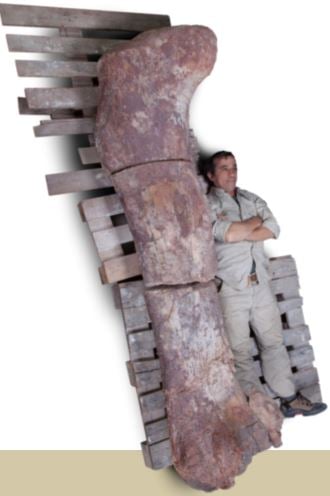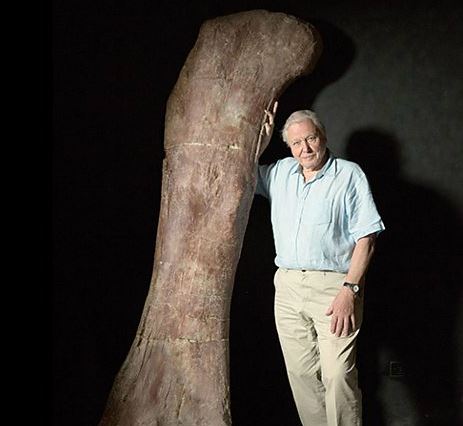There will be a documentary later this month on the mega giant dinosaur species Titanosaur, the largest known dinosaur that was estimated to have weighed up to 70 tonnes, i.e. more than fourteen times heavier than today’s African Bush Elephant.
Scientists believe that the Titanosaur discovered in Argentina was the largest animal ever to walk the Earth. It existed about ninety-five million years ago, during the late Mesozoic era, when dinosaurs dominated terrestrial ecosystems.
Two years ago, a shepherd saw the tip of a massive fossil bone protruding from a rock in La Flecha Farm in the Chubut Province in Patagonian Argentina, an area of vast plains between the Andes Mountains and the Atlantic Ocean.
 The Tiranosaurus was probably the largest animal ever to walk the Earth. (Image: mef.org.ar)
The Tiranosaurus was probably the largest animal ever to walk the Earth. (Image: mef.org.ar)
Scientists set up camp as soon as they heard
When palaeontologists (fossil scientists) at the Museo Paleontológico Egidio Feruglio (Egidio Feruglio Paleontology Museum) in Trelew, a city in the province of Chubut, heard about it, they went to the discovery site and set up camp.
The first bone they unearthed was a 2.4 metre-long (7.9 feet) femur (thigh bone), the largest ever discovered. They eventually uncovered over 220 bones, which came from a total of seven different dinosaurs, all belonging to the new species of the herbivorous titanosaur, which does not have its own scientific name yet.
Excavation team leader, Dr. Diego Pol, who works at the Museum, said:
“It was like a paleontological crime scene, a unique thing that you don’t find anywhere else in the world with the potential of discovering all kinds of new facts about titanosaurs. According to our estimates this animal weighed 70 tons.”
“A comparison of the back bones shows that this animal was 10 per cent larger than Argentinosaurus, the previous record holder. So we have discovered the largest dinosaur ever known.”
José Luis Carballido, a dinosaur specialist and team leader in the study of these specimens, who works at the Museum, said:
“It’s a real paleontological treasure. There were lots of fossils in great preservation, practically intact, something that does not happen often. In fact, the remains of giant Titanosaurs known so far are scarce and fragmentary.”
 The dinosaur’s femur (thigh bone) was 2.4 metres long. (Image: mef.org.ar)
The dinosaur’s femur (thigh bone) was 2.4 metres long. (Image: mef.org.ar)
The Documentary – Attenborough and the Giant Dinosaur – follows the twists and turns of this forensic study over a period of two years.
Learn about this giant’s lifestyle
Sir David watches the unearthing, cleaning and examination of these vast fossil specimens for the first time. The documentary, using state-of-the art graphics, shows what researchers think the internal structure of the dinosaur looked like, and how it moved and functioned.
Before this remarkable find, scientists across the world had an idea that these giants probably existed, but knew very little about them, because the very few specimens available were badly preserved.
 Sir David spoke to BBC Today programme (radio) presenter Nick Robinson about the dinosaur and how they worked out its dimensions from the bones that were found. (Image: bbc.co.uk)
Sir David spoke to BBC Today programme (radio) presenter Nick Robinson about the dinosaur and how they worked out its dimensions from the bones that were found. (Image: bbc.co.uk)
Sir David takes the viewer to the fossil site to witness the unearthing of these enormous specimens, and the Museum labs in Trelew where they are cleaned and studied further.
He talks to palaeontologists and comparative anatomy experts, who explain what the bones of these prehistoric giants tell us about their lives, with the help of 3D scanning, CGI visuals and computer animation.
At the end of the documentary you can witness the unveiling of the magnificent, 37-metre-long skeleton model of the newly-discovered titanosaur, built by a team of Argentinian and Canadian model makers.
Sir David talks to lead scientist on the excavation, Dr. Diego Pol, as well as evolutionary biologist Ben Garrod.
Perhaps they died in a drought
Finding seven adult specimens all in the same place in that type of environment leads one to speculate why the animals died in the same place, at more or less at the same time.
Perhaps there was a watering hole there, and during a period of drought they congregated and died of dehydration, or maybe the drought had made them weak and they got stuck in the mud, the scientists suggest.
 The paleontologists were amazed at the size of the fossil bones. (Image: mef.org.ar)
The paleontologists were amazed at the size of the fossil bones. (Image: mef.org.ar)
The presence of so many large dead animals would have meant rich pickings for large scavenging dinosaurs such as Tyrannotitan.
Carballido said:
“They probably frequented the place to scavenge the remains of herbivores. But the feast had high price: to bite hard skin and flesh of these giants often broke their teeth, that later regenerated.”
Prehistoric remains of large plants were found at the excavation site, including large logs and imprints of leaves that reveal a completely different Patagonian landscape. Ninety-five million years ago there was an abundance of huge trees in the area, and lower strata flowering plants (angiosperms), the researchers said.
BBC Video Trailer – Largest creature to walk the Earth: Titanosaurus
On Sunday 24 January on BBC 1, Sir David Attenborough will talk about the fossil discovery and reconstruction in Argentina of the largest known dinosaur, a new species of Titanosaur.


Comments are closed.